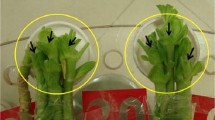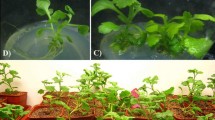Abstract
We investigated the effect of tissue source selection in combination with ion beam irradiation on generating flower-color mutants in Chrysanthemum morifolium. Flower color mutation in the chrysanthemum cultivar YoMystery (purple flowers) was used as an index to estimate mutation frequency and the spectrum of mutations. Somaclones regenerated from petal and leaf tissues and ion-beam irradiated clones derived from the two tissues were analyzed for stem length and flower color mutation. Three Gy of argon ion beams was regarded as an appropriate dose for irradiation because the resulting color mutants maintained an adequate stem length suitable for commercial use even with high mutation frequencies. Statistical analysis of 7,258 individuals from three separate experiments revealed that (1) somaclones from petal tissue had a higher mutation frequency (2.91 %, σ = 0.55) than leaf somaclones (2.01 %, σ = 0.26); (2) the effect of tissue source on the frequency of flower color mutations was significantly enhanced when combined with ion-beam irradiation in that the mutation frequency of ion-beam irradiated petal clones was 6.47 % (σ = 0.77), whereas that of ion-beam irradiated leaf clones was 3.89 % (σ = 0.52); and (3) the spectrum of carotenoid color mutations was remarkably increased by ion-beam irradiation in that both leaf and petal ion-beam irradiated clones had brown, red and yellow flowers in contrast to the somaclones that only produced yellow flowers. These results suggest that intentional or directed induction of flower color mutants with practical value is possible by combining tissue source selection with ion beam irradiation.





Similar content being viewed by others
Notes
E: Accelerated beam energy of the particle in MeV/u (MeV/a.m.u. or MeV/nucleon).
LET: Linear Energy Transfer, (Rate of energy dissipation along the path of charged particles. In radiobiology and health physics, exposure is measured in kiloelectron volts per micrometer of tissue (keV/micrometer)).
References
Broertjes C, van Harten AM (1988) Applied mutation breeding for vegetatively propagated crops. Elsevier Science Publisher B. V, Amsterdam
Bush SR, Earle ED, Langhans RW (1976) Plantlets from petal segments, petal epidermis and shoot tips of the periclinal chimera Chrysanthemum morifolium ‘Indianapolis’. Am J Bot 63:729–737
Chen SM, Li CH, Zhu XR, Deng YM, Sun W, Wang LS, Chen FD, Zhangi Z (2012) The identification of flavonoids and the expression of genes of anthocyanin biosynthesis in the chrysanthemum flowers. Biologia Plantarun 56:458–464
De Jong J, Custers JBM (1986) Induced changes in growth and flowering of chrysanthemum after irradiation and in vitro culture of pedicels and petal epidermis. Euphytica 35:137–148
Elia MC, Bradley MO (1992) Influence of chromatin structure on the induction of DNA double strand breaks by ionizing radiation. Cancer Res 52:1580–1586
Evans DA (1989) Somaclonal variation-genetic basis and breeding applications. Trend Genet 5:346–350
Hase Y, Akita Y, Kitamura S, Narumi I, Tanaka A (2012) Development of an efficient mutagenesis technique using ion beams: toward more controlled mutation breeding. Plant Biotechnol 29:193–200. doi:10.5511/plantbiotechnology.12.0106a
Inagaki Y, Hisatomi Y, Suzuki T, Kasahara K, Iida S (1994) Isolation of a suppressor-mutator/enhancer-like transposable element, Tpn1, from Japanese morning glory bearing variegated flowers. Plant Cell 6:375–383
Itoh Y, Higeta D, Suzuki A, Yoshida H, Ozeki Y (2002) Excision of transposable elements from the chalcone isomerase and dihydroflavonol 4-reductase genes may contribute to the variegation of the yellow-flowered carnation (Dianthus caryophyllus). Plant Cell Physiol 43:578–585. doi:10.1093/pcp/pcf065
Jain SM (2001) Tissue culture-derived variation in crop improvement. Euphytica 118:153–166
Karp A (1995) Somaclonal variation as a tool for crop improvement. Euphytica 85:295–302
Kishimoto S, Ohmiya A (2006) Regulation of carotenoid biosynthesis in petals and leaves of chrysanthemum (Chrysanthemum morifolium). Physiol Plantarum 128:436–447
Ladygin VG (2000) Biosynthesis of carotenoids in plastids of plants. Biochem Biokhimiia 65:1113–1128
Larkin PJ, Scowcroft WR (1981) Somaclonal variation—a novel source of variability from cell culture for plant improvement. Theor Appl Genet 60:197–214
Murashige T, Skoog F (1962) A revised medium for rapid growth and bio assays with tobacco tissue cultures. Physiol Plantarum 15:473–497
Nagatomi S, Tanaka A, Watanabe H, Tano S (1997) Chrysanthemum mutants regenerated from in vitro explants irradiated with 12C5 ion beam. Institute of radiation breeding, technical news No.60
Newman HC, Prise KM, Michael BD (2000) The role of higher-order chromatin structure in the yield and distribution of DNA double-strand breaks in cells irradiated with X-rays or alpha-particles. Int J Radiat Biol 76:1085–1093
Ohmiya A, Kishimoto S, Aida R, Yoshioka S, Sumitomo K (2006) Carotenoid cleavage deoxygenase (CmCCD4a) contributes to white color formation in chrysanthemum petals. Plant Physiol 142:1193–1201. doi:10.1104/pp.106.087130
Okamura M (1994) Pomato: potato protoplast system and somatic hybridization between potato and a wild tomato. In: Bajaj YPS (ed) Biotechnology in agriculture and forestry, somatic hybridization in crop improvement I. Springer-Verlag, New York, pp 209–223
Okamura M, Yasuno N, Ohtsuka M, Tanaka A, Shikazono N, Hase Y (2003) Wide variety of flower-color and -shape mutants regenerated from leaf cultures irradiated with ion beams. Nucl Instrum Methods Phys Res B 206:574–578. doi:10.1016/S0168-583X(03)00835-8
Okamura M, Tanaka A, Momose M, Umemoto N, da Silva JAT, Toguri T (2006) Advances of mutagenesis in flowers and their industrialization. In: da Silva JAT (ed) Floriculture, ornamental and plant biotechnology, vol 1., Global science booksIsleworth, Middlesex, pp 619–628
Okamura M, Nakayama M, Umemoto N, Cano EA, Hase Y, Nishizaki Y, Sasaki N, Ozeki Y (2013) Crossbreeding of a metallic color carnation and diversification of the peculiar coloration by ion-beam irradiation. Euphytica 191:45–56. doi:10.1007/s10681-012-0859-x
Radulescu I, Elmroth K, Stenerlöw B (2004) Chromatin organization contributes to non-randomly distributed doublestrand breaks after exposure to high-LET radiation. Radiat Res 161:1–8
Rout GR, Das P (1997) Recent trends in the biotechnology of chrysanthemum: a critical review. Sci Hortic 69:239–256
Salamon MH (1980) A range-energy program for relativistic heavy ions in the region 1 < E<3000 MeV/amu. Report 10446, Lawrence Berkeley Laboratory, Berkeley, CA
Shikazono N, Yokota Y, Kitamura S, Suzuki C, Watanabe H, Tano S, Tanaka A (2003) Mutation rate and novel tt mutants of Arabidopsis thaliana induced by carbon ions. Genetics 163:1449–1455
Shikazono N, Noguchi M, Fujii K, Urushibara A, Yokota A (2009) The yield, processing, and biological consequences of clustered DNA damage induced by ionizing radiation. J Radiat Res 50:27–36
Sihver L, Schardt D, Kanai T (1998) Depth-dose distributions of high energy carbon, oxygen and neon beams in water. Jpn J Med Phys 18:1–21
Skirvin RM, Janick J (1976) Tissue culture- induced variation in scented Pelargonium spp. J Amer Soc Hort Sci 101:281–290
Stadler LJ (1928) Mutations in barley induced by X-rays and radium. Science 68:186–187
Tanaka A (2012) Targeted mutation breeding of flower color by taking advantage of ion-beam irradiation and genomic information. Plant Biotechnol 29:191–192. doi:10.5511/plantbiotechnology.12.0002p
Tanaka Y, Sasaki N, Ohmiya A (2008) Biosynthesis of plant pigments: anthocyanins, betalains and carotenoids. Plant J 54:733–749
Tanaka A, Shikazono N, Hase Y (2010) Studies on biological effects of ion beams on lethality, molecular nature of mutation, mutation rate, and spectrum of mutation phenotype for mutation breeding in higher plants. J Radiat Res 51:223–233. doi:10.1269/jrr.09143
Torikoshi M, Minohara S, Kanematsu N, Komori M, Kanazawa M, Noda K, Miyahara N, Itoh H, Endo M, Kanai T (2007) Irradiation System for HIMAC. J Radiat Res 48:A15–A25
The Joint FAO/IAEA Programme, mutant variety database (MVGS). http://mvgs.iaea.org/default.aspx
van Harten AM (1998) Mutation breeding, theory and practical applications. Cambridge University Press, New York
Yamaguchi H, Shimizu A, Degi K, Morishita T (2008) Effects of dose and dose rate of gamma ray irradiation on mutation induction and nuclear DNA content in chrysanthemum. Breeding Sci 58:331–335
Yoshida H, Itoh Y, Ozeki Y, Iwashina T, Ymaguchi M (2004) Variation in chalcononaringenin 2′-O-glucoside content in the petals of carnations (Dianthus caryophyllus) bearing yellow flowers. Scientia Horiticulturae 99:175–186
Acknowledgments
The authors thank Dr. Masayoshi Nakayama for useful discussions and the technical staff who established the ion beam irradiation system. This project was partly performed within the Heavy Ion Medical Accelerator in Chiba (HIMAC) co-operative research program (B340) at the National Institute of Radiological Sciences, Chiba, Japan.
Author information
Authors and Affiliations
Corresponding author
Rights and permissions
About this article
Cite this article
Okamura, M., Hase, Y., Furusawa, Y. et al. Tissue-dependent somaclonal mutation frequencies and spectra enhanced by ion beam irradiation in chrysanthemum. Euphytica 202, 333–343 (2015). https://doi.org/10.1007/s10681-014-1220-3
Received:
Accepted:
Published:
Issue Date:
DOI: https://doi.org/10.1007/s10681-014-1220-3




